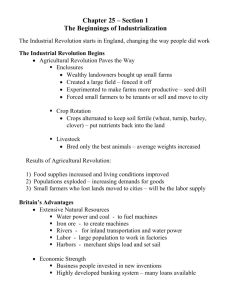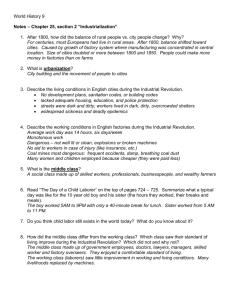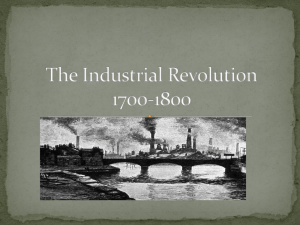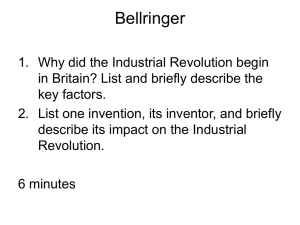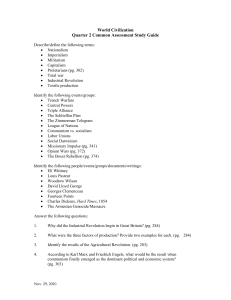File - Mr.Bailey's AP World History Website
advertisement
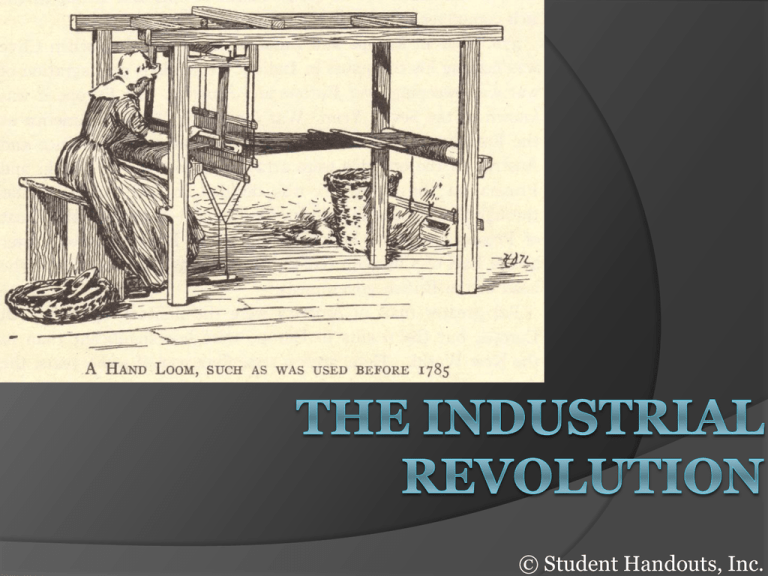
© Student Handouts, Inc. ABOARD Assessment OBJ: What factors led to the Time: 6:45 Minutes Industrial Revolution Complete ABOARD Do advancements in Assessment technology improve You may use your people’s lives? notes 1. Scientific Revolution You MAY NOT use the 2. Commercial Revolution reading 3. Putting-out system When you finish: Remain silent 4. Why England? 5. Technological advancements Announcements Homework Reading on Industrial Revolution Happy Birthday: Ricky Gomez and Josie Hernandez Big Question of the Week Do advancements in technology improve people’s lives? Scientific Revolution Scientific revolution created a, Greater knowledge of the world, Weakened superstition and tradition, and Encouraged learning and the search for better and newer ways of doing things Most important to the process of industrialization were the advancements in physics made by Sir Isaac Newton and James Watt Commercial Revolution During the 16th, and 17th centuries Europeans expanded their power worldwide Colonies in the Americas and Asia brought new trade and commerce ( business) to Europe Trading/Merchant guilds from before could not meet rising demands Putting-out System As the demand for goods increased a new system of production was made in which Businesspeople delivered raw materials to workers’ homes where they manufactured the goods Business owners picked up finished goods and paid workers wages based on number of items Why England? 1. 2. 3. 4. England became the birthplace of the industrial revolution for 4 reasons: Increased agricultural production, Merchants and the upper-class had new capital to invest England could sell goods back to the colonies England had the natural resources of coal to produce Technological Advancements Flying Shuttle (John Kay) 1720’s, increased efficiency of weaving Demand for textiles (woven cloth) 1700’s increases Steam powered Power Loom (1785) invented, made production 8x faster “Necessity Is the Mother of Invention” Power Loom leads to increased demand for cotton Cotton gin is invented by Eli Whitney, separates cotton faster Demand for Iron increases as the demand for the power loom increases Technological advancements As more steampowered machines were built, factories needed more coal to create this steam Mining methods improved to meet the demand for more coal “Necessity Is the Mother of Invention” As more steampowered machines were built, factories needed more coal to create this steam Mining methods improved to meet the demand for more coal •The process of inventing never ends •One invention inevitably leads to improvements upon it and to more inventions The life of Betty Harris 1.What is the job of a drawer? 2. Why was this job especially hard for women? 3.Why was it hard for Harris to have a comfortable family life? 4.How did the advancements in technology change people’s lives? OBJ: What impact did Industrialization have on the lives of Europeans? 1. 2. 3. 4. 5. 6. Increase Transportation Investment in Agriculture Growth of factory Urbanization Change in Lifestyle Spread of Industrialization Announcements Homework Reading on Industrial Revolution Due Tomorrow RAFT Quick Write Role: Journalist Audience: Citizens of England Format: 5 Sentence news article Theme: The Growth of Manchester Questions to think about: How has Manchester changed over the last 100 years? Why would Manchester be a great place to move to? Increase in Transportation Prior to the Industrial Revolution, people used ships with sails and horse-drawn carriages Increased production Search for more markets and raw materials Better and faster means of transportation Steamboat (1807) – Increased speed of water transportation Locomotive (1825) Fast land transportation of people and goods Investment in Agriculture As demand for cotton increased and people moved to cities, governments invested in agricultural research by establishing agricultural schools, societies, and experimental stations Led to new innovation in pesticides, breeding, food preservation, and farming techniques, allowed fewer farms to produce more food Growth of Factories By 1800, steam engines were replacing water wheels as sources of power for factories, forcing owners to relocate near raw materials Cities grew around the factories built near central England’s coal and iron mines Manchester, Liverpool Urbanization With the growth of factories in cities and the decline of agriculture people began searching for work within cities Cities such as London and Manchester soon became over populated with working class citizens Urban populations increased by over 400% Change in lifestyle Pre-Industrial Revolution: Owned their own farms where they produced their own food and clothing. This made Unemployment rare Within the urban city, workers relied entirely upon their employers for wages with which they bought everything they needed The Spread of the Industrial Revolution Mid-1800s – Great Britain, the world attempted to ban the export of its methods and technologies, but this soon failed 1812 – United States industrialized after the War of 1812 1825 – France Industrialized following Napoleonic Wars 1870 – Germany industrialized rapidly By 1890 – Russia and Japan began to industrialize The Debate: Issues and Responses Prompt: Identify the issues raised by the growth of Manchester and analyze the various responses to those issues over the course of the 19th century Source Analysis Prompt: Identify the issues raised by the growth of Manchester and analyze the various responses to those issues over the course of the 19th century

